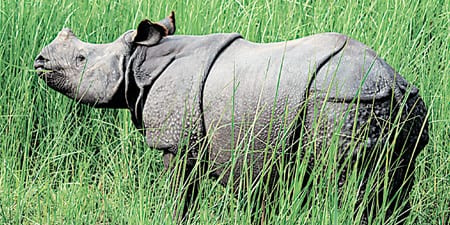Eco tourism in the wild
Local communities in Dudhwa Tiger Reserve are being successfully engaged in eco tourism initiatives – from encouraging girls to get trained as nature guides to helping local people manage government owned accommodation where tourists can stay By Sudipta Dev
The forests and grasslands of the Terai region in Uttar Pradesh is home to the Royal Bengal Tiger. Dudhwa Tiger Reserve comprises of three Protected Areas – Dudhwa National Park, Kishanpur Wildlife Sanctuary (both in Lakhimpur-Kheri district of Uttar Pradesh), and the Katerniaghat Wildlife Sanctuary. About 20 per cent of the core area of the Dudhwa National Park is open for eco tourism for the public. “We have identified certain routes. The number of persons going per day is decided as it is a very delicate ecological balance. These are the preserves of wilderness and there has to be least intervention from man in places like Dudhwa,” says Sanjaya Singh, field director, Dudhwa Tiger Reserve, pointing out that the entry of number of vehicles per day is also fixed along with the limit in specific times for allowing the number of tourists. He acknowledges that at present there is large potential in terms of capacity, as there is not much awareness about Dudhwa among tourists. UP Forest Corporation is the nodal agency for eco tourism initiatives in the state.
Though Dudhwa National Park comes under Project Tiger, the flagship species of the park is the swamp deer. It has the second highest number of swamp deer in Asia. It is also home to the one horned rhino which was introduced in the park in the mid 80s. “Other than Kaziranga National Park in Assam you can see the one horned rhino only in Dudhwa. We had started with seven rhinos in the eighties, now the numbers are more than 30,” mentions Singh.
The rhinos habitat is the big grasslands of the region. It is also a birdwatcher’s paradise – more than 400 plus varieties of birds can be found in the area. “Our USP for the rich luxurious forests of Katerniaghat is – where rare is common. Gangetic dolphin, Gangetic crocodile, alligator, vultures – in one trip you can see all the four. This is apart from leopards, tigers, rhinos, and other animals,” adds Singh.
Community engagement
 No eco tourism initiative can be successful without engaging the local community. At Dudhwa Tiger Reserve, efforts have been made to encourage local girls to become nature guides. “Currently there are five women nature guides who are doing very well,” informs Singh.
No eco tourism initiative can be successful without engaging the local community. At Dudhwa Tiger Reserve, efforts have been made to encourage local girls to become nature guides. “Currently there are five women nature guides who are doing very well,” informs Singh.
The guides have been trained to spot the flora and fauna – birds, reptiles, climbers, shrubs. “We do not invite people for tiger safari, we tell them to come and feel the forest,” asserts Singh. The new initiatives include photographic safari. An upcoming project is bird safari with photography.
All the guides are sensitive about conservation and protection of environment. The Protected Areas, claims Singh, is free of polythene. The guides carry with themselves jute bags, if by chance a tourist has left litter on the road, they will stop the vehicle and collect the object. Incidentally, the speed limit for vehicles is 25 to 30 km in the area.
There are few hospitality projects near Dudhwa Tiger Reserve and the local communities are being encouraged to be involved in such projects. In Dudhwa National Park there are 14 huts other than rest houses, which are government owned. These rest houses are heritage properties, more than 100 years old. The oldest was built in 1870. With the state chief minister having given permission for restoration, efforts are being made to rope in experts on heritage properties who can give advice on how to maintain these structures. In terms of modern accommodation there are plans for tented Swiss cottages in the vicinity.
In Katerniaghat there are eight huts along with dormitories. The local people have been trained to manage these properties.


